The Stringed Instrument Database
S

Sape
Alternative names: Sampeh, Sapeh, Sampet, Boat lute
Origin: Indonesia.
Tuning:
Strings/Courses:
Further notes:
Scale Length: 800-1000mm
Samica
- See Dangubica
Sanshin
Alternative names: Jabisen
Origin: Ryukyu Islands, Japan.
Tuning: C3, F3, C4
Strings/Courses: 3/3
Further notes: Japanese for 'three strings'. Nylon strings.
Scale Length: 600mm

Sanshin, Kankara
Alternative names:
Origin: Okinawa, Japan. During World War II.
Tuning: C3, F3, C4
Strings/Courses: 3/3
Further notes: During World War II, the Japanese could not get hold of the wood or skin required to make a normal Sanshin, so this type was invented. Kankara means 'from a tin'. Nylon strings, although originally made from Parachute lines.
Scale Length:

Sanxian
Alternative names:
Origin: China. Evolved into the Sanshin and later the Shamisen in Japan (see above and below).
Tuning: C3, G3, C4 or A2, D3, A3 or D3 A3, D4 or G2, D3, G3.
Strings/Courses: 3/3
Further notes:
Scale Length:
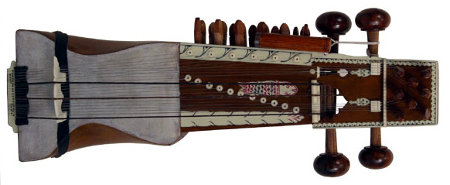
Sarangi (Indian)
Alternative names: Surangi
Origin: Northern India, 18th century.
Tuning:
Strings/Courses: 3/3 or 4/4
Further notes: The playing strings are gut, the sympathetic strings (about 35 of them!) are steel.
Scale Length:
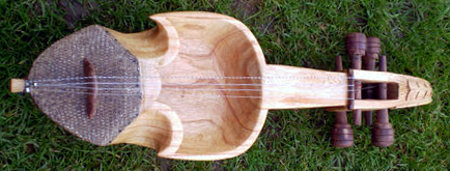
Sarangi (Nepalese)
Alternative names:
Origin: Nepal.
Tuning: G4, C5, C5, G5
Strings/Courses: 4/4 or 3/3
Further notes: The strings are usually steel but can sometimes be gut.
Scale Length: 250-270mm
Saraswati Veena
- See Veena

Sargija
Alternative names: Sharkia, Sharki, Shargija
Origin: Originated in Bosnia during the Ottoman Empire's rule (1463-1878)
Tuning: C3 C3, G3 G3, D3 D3
Strings/Courses: 6/3
Further notes: Metal strings, usually steel.
Scale Length: 960mm
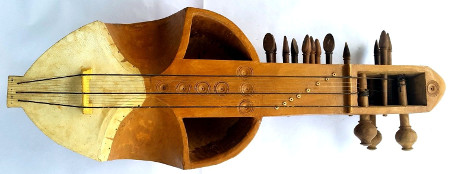
Sarinda
Alternative names:
Origin: Bangladesh
Tuning:
Strings/Courses: 3/3, plus sympathetic strings.
Further notes:
Scale Length:

Sarod
Alternative names:
Origin: India.
Tuning: A#2, F3, A#3, D#4.
Strings/Courses: 4/4 with sympathetic strings
Further notes:
Scale Length: Around 640mm, but varies.
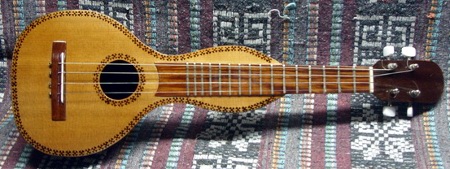
Sachaguitarra
Alternative names:
Origin: Created by Elpido Herrera in 1971 in Argentina.
Tuning:
Strings/Courses: 4/4, 5/5 or 6/6
Further notes: Steel strings. Played both with the fingers and with a small bow.
Scale Length:

Sato
Alternative names:
Origin: Tajikistan and Uzbekistan.
Tuning:
Strings/Courses: 4/4 or 5/5
Further notes: Nylon or gut strings.
Scale Length: About a metre.

Saw Sam Sai
Alternative names: So Sam Sai, Sa Samsai, Sam Sai
Origin: Thailand.
Tuning:
Strings/Courses: 3/3
Further notes: Thai for 'three stringed fiddle'.
Scale Length:

Saz
Alternative names: Baglama
Origin: Turkey
Tuning: G3 G2, D3 D3, A3 A2 A3 for long neck versions. C4 C3, G3 G3, D4 D3 D4 for short neck versions.
Strings/Courses: 7/3 or 6/3. If 6/3, the upper course is double instead of tripled, and this is usually the case on the smaller instruments.
Further notes: Steel strings.
Scale Length: About 550mm for the short necked versions. About 800mm for the long necked versions.

Scheitholt
Alternative names:
Origin: Germany. Earliest mention from the 16th century but probably existed earlier.
Tuning:
Strings/Courses:
Further notes: Nowadays usually steel strings, but traditionally brass or gut. Was taken to the USA by German immigrants, where it evolved into the Dulcimer.
Scale Length: Usually 600-850mm

Setar
Alternative names: Sehtar
Origin: Iran, 9th century.
Tuning: C3 C4, G3, C4
Strings/Courses: 4/3
Further notes:
Scale Length: Around 650mm

Shamisen
Alternative names: Samisen, Sangen, Jamisen
Origin: Japan, 16th century. Evolved from the Sanshin (see above).
Tuning: D, G, D
Strings/Courses: 3/3
Further notes: Nylon or silk strings.
Scale Length: 600-1000mm

Shurangiz
Alternative names: Shourangiz
Origin: Iran, 20th century. Developed from the Setar by Hossein Alizadeh.
Tuning:
Strings/Courses:
Further notes: A longer neck and more frets than the Setar and has skin on the front.
Scale Length: 660mm

Sintir
Alternative names: Hejhouj, Sintyr, Kimbry, Sentir, Hajhuj.
Origin: The Sahara desert, Africa.
Tuning: No absolute pitch, but the 2nd string is tuned a 4th above the 1st (lowest) string, and the 3rd is tuned an octave above the 1st string.
Strings/Courses: Usually 3/3
Further notes: Gut or rope strings.
Scale Length: Varies. Anywhere between 450-750mm.

Sirincho
Alternative names: Guitarrita
Origin: Paracho, Mexico.
Tuning:
Strings/Courses: 6/5
Further notes:
Scale Length:

Sitar
Alternative names:
Origin: India, 13th century.
Tuning:F2, C2, G2, C2, G3, C4, C5
Strings/Courses: 7/7
Further notes: 3 drone strings, 5 melody strings, usually 12 sympathetic strings. Sympathetic strings are tuned depending on the raga being played. Steel strings.
Scale Length: 680-870mm
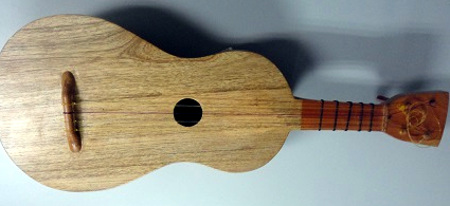
Socavon
Alternative names: Bocona
Origin: Panama
Tuning: G3, D4, A4, B3.
Strings/Courses: 4/4
Further notes: Nylon strings.
Scale Length:400-440mm

Sohaegeum
Alternative names:
Origin: North Korea, 1960's.
Tuning:
Strings/Courses: 4/4
Further notes:
Scale Length:

Sorahi
Alternative names:
Origin: Iran, 20th century. Invented by Mohammad-Reza Shajarian.
Tuning:
Strings/Courses:
Further notes:
Scale Length:
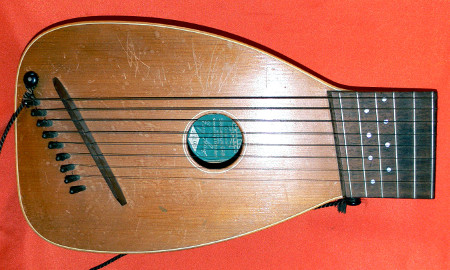
Stoessel Lute
Alternative names: Stössel Laute (German name).
Origin: Invented by Georg Stössel in 1914 in Cologne (Köln), Germany.
Tuning: Various models, each with different numbers of strings and tunings. Most have single courses but some of the earlier ones have double.
Strings/Courses:
Further notes: Played by putting your fingers over the end of the neck to press down the frets instead of round the neck itself.
Scale Length: Various models, each with different scale lengths.
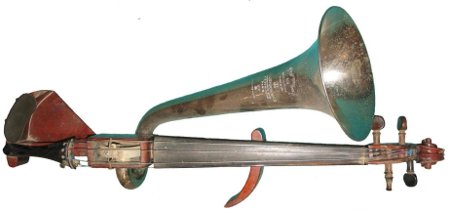
Strohviol
Alternative names: Stroviol, Stroh violin, horn-violin, Phono fiddle, trumpet violin.
Origin: Germany, 1899. Invented by Johannes Matthias Augustus Stroh, in London, England.
Tuning: Depends on the type.
Strings/Courses: Depends on the type.
Further notes: Instead of using a soundbox, the instrument is amplified using a horn. The design is based on a Gramophone, and they were especially useful for recording onto Gramophones because they are very directional. There are single string models, violin models, viola models and even a stroh-ukulele. Steel strings for the violin type.
Scale Length: Depends on the version. Violin models follow the standard violin scale length, for example.

Strumstick
Alternative names: Dulcitar, Stick Dulcimer, Dulcimer Stick, Dulcijo, Picking Stick, Strumbly, Sweetstick, Walking Dulcimer, Walkabout Dulcimer, Nursery rhyme machine.
Origin: USA, 1930's. Re-branded as the Strumstick towards the end of the 20th century, and this is now the most popular and common name. A very similar instrument invented in the UK for use by children is the 'nursery rhyme machine'.
Tuning: D, G, D or C, G, C or D, A, D or similar.
Strings/Courses: 3/3 or 4/3
Further notes: Steel strings.
Scale Length: A wide variation, but usually between 500-650mm
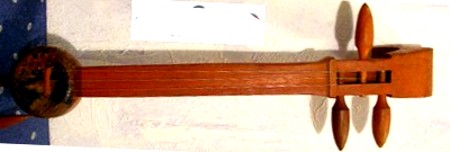
Subu
Alternative names: Sung Lisu, Tseubeu, Sae Mu.
Origin: Northern Thailand
Tuning:
Strings/Courses: 3/3
Further notes:
Scale Length: Lots of variations, but usually between 330mm and 750mm.
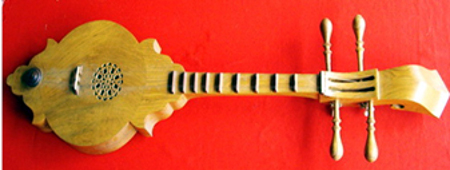
Sueng
Alternative names: Soong
Origin: Thailand
Tuning:
Strings/Courses: 4/4 or 4/2
Further notes: Steel strings.
Scale Length: 410mm

Sundatang
Alternative names: Sundantang
Origin: Malaysia
Tuning:
Strings/Courses:
Further notes:
Scale Length:

Surbahar
Alternative names: Sur Bahar, Bass sitar (outside India).
Origin: India
Tuning:
Strings/Courses:
Further notes: Steel strings.
Scale Length: 900-1200mm

Sursringar
Alternative names:
Origin: India.
Tuning:
Strings/Courses:
Further notes: Steel and Bronze strings.
Scale Length:

Suuk Khuur
Alternative names: Suu Khur, Shu Khur, Shook Koor,
Origin: Mongolia
Tuning:
Strings/Courses: 1/1 or 2/2
Further notes:
Scale Length: